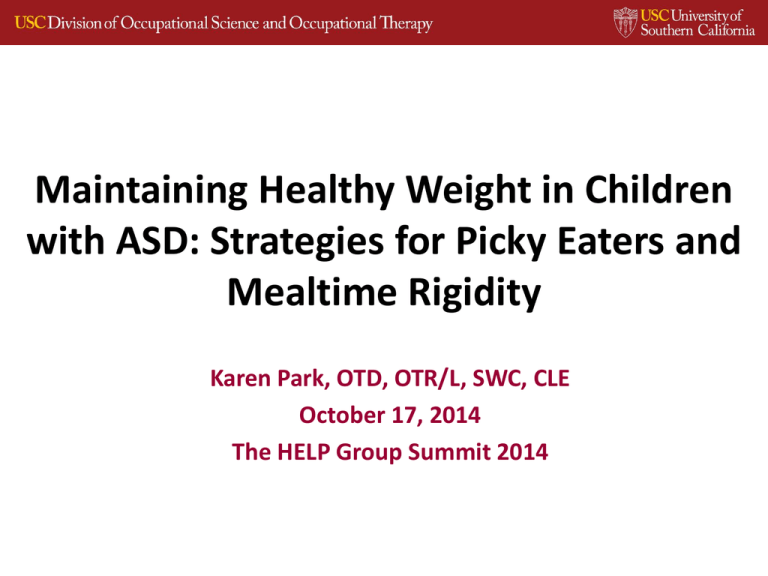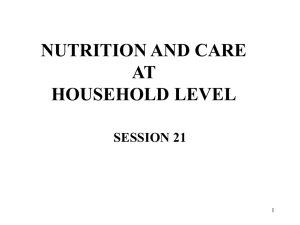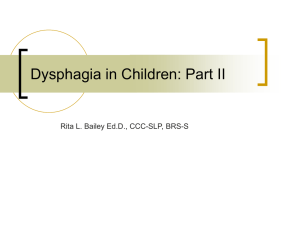Maintaining a Healthy Weight in Children with ASD
advertisement

Maintaining Healthy Weight in Children with ASD: Strategies for Picky Eaters and Mealtime Rigidity Karen Park, OTD, OTR/L, SWC, CLE October 17, 2014 The HELP Group Summit 2014 Learning Objectives • Describe multiple interrelated factors that influence the occupation of mealtime and the management of healthy weight in children. • To understand the current challenges of maintaining healthy weight in children and adolescents including those in underserved populations. • To understand the unique challenges of maintaining healthy weight in children with special healthcare needs. • To utilize specific strategies to discuss and manage weight with families and children with feeding disorders or selective feeding behaviors. • To explore the interdisciplinary approach to support unique needs of clients with special healthcare needs with feeding disorders. Eating/Feeding/Swallowing • Eating: The ability to keep and manipulate food/fluid in the mouth and swallow it. • Feeding: The process of setting up, arranging, and bringing food/fluids from the plate or cup to the mouth. • Swallowing: a complicated act in which food, fluid, medication, or saliva is moved from the mouth through the pharynx and esophagus into the stomach. Mealtime as an Occupation • Communication • Socialization • Context of family, culture, & community • Sharing personal values related to eating • • • • • Celebration Physical growth and health Sensory exploration Relaxation Pleasure and enjoyment Person-Environment-Occupation (PEO) Model Law, M., Cooper, B,. Strong, S., Stewart, D., Rigby, P. & Letts, L. 1996. The Person-Environment-Occupation Model: A transactive approach to occupational performance. Canadian Journal of Occupational Therapy. 63(1):9-23 Social Ecological Model Prevalence of Feeding Difficulties • Feeding difficulties occur in: – 25% of children in the general population – Up to 80% of children with severe to profound mental retardation – More prevalent in children with developmental disabilities, with rates up to 74% (Ledford & Gast, 2006). – Anecdotal accounts of significant feeding challenges Feeding Difficulties in Children with ASD • Behavioral feeding disorders, including aversive eating behaviors • Sensory-based feeding problems • Medical factors Feeding Disorders and ASD • Child Factors – Concentration on detail – Fear of novelty/ritualistic – Sensory processing impairments – Deficits in social compliance – Biological food intolerance gut-based, GI factors **Mealtime Behaviors** Feeding Disorders and ASD • Caregiver/Environmental Factors – Caregiver/family values – Caregiver attitude towards child’s abilities and challenges – Reinforcement of negative feeding patterns – Communication difficulties Implications of Feeding Disorders • • • • Nutritional impact and healthy weight Attachment may be negatively affected Early feeding difficulties persist over time Untreated feeding difficulties may evolve into eating disorders in adolescence and adulthood • Caregivers experience heightened parentingrelated stress Role of Occupational Therapist • Understand family’s goals and priorities • Gather information regarding feeding environment, family mealtime routine • Determine current developmental level/feeding skills/swallowing function • Consider interplay of psychosocial, behavioral, and cognitive factors • Quality of life for child and family Family Centered Care • Viewing child within context of family • Family as the expert on the child’s abilities and needs • Identify strengths and needs of family • Family works together to make informed decisions Occupational Therapy Assessment • Caregiver interview • Posture and positioning • Motor control related to utensil use and selffeeding skills • Anatomical structures • Neuromotor • Sensorimotor • Respiratory Function Caregiver Interview • • • • • • Prenatal care Birth complications Surgeries/ hospitalizations Early feeding history Developmental milestones Invasive procedures, including tube feeding or force feeding • Temperament • Other regulatory areas, such as sleeping and toilet training • Previous assessments and evaluations Caregiver Interview: Family System • Who resides in the home? • Who generally feeds the child? • Is there any difference in the child’s feeding when fed by a different caregiver? • Does the child participate in family mealtime? • Family resources and strengths • Services (school district, Regional Center) • Cultural needs • Family’s goals and expectations Caregiver Interview: Child Factors • Preferred and non-preferred foods • Preferred and non-preferred flavors and textures • Mealtime schedule and structure • Daily intake • Independent feeding skills • Cues of hunger and satiety • Feeding in different contexts (home, school) Posture and Positioning • Observation of sitting posture • Positioning – Lap – High chair – Child size chair • Postural control • Strength and endurance Upper Extremity Motor Control • Finger feeding • Self feeding skills with utensils – Grasp on utensil – Coordination and efficiency – Motivation and experience • Bilateral coordination Anatomical Structures • Lips • Tongue • Palate (Hard & Soft) • Jaw • Dentition • Cheeks Neuromotor • Oral facial muscle tone • Range of motion of oral structures • Reflexes (rooting, suck/swallow, gag, cough) • Jaw stability and strength • Chewing • Tongue movements • Lips and cheeks Sensory Processing • • • • • • • • Tactile Proprioceptive Vestibular Auditory Olfactory Visual Self-regulation/ Modulation Sensorimotor related to Feeding • Response to taste, textures, temperature • Hyper/hypo responsiveness • Sensory Modulation • Oral praxis Respiratory Status • Respiration • Vocal Quality • Airway Protection • Swallow safety sciencewithme.com Feeding Observation: Child Factors • • • • Motivation and interest in feeding Affect presentation Eye contact and attentiveness Ability to remain calm and regulated during feeding • Anticipation of and responsiveness to caregiver prompts • Engages in self-feeding as developmentally appropriate Feeding Observation: Parent Factors • Attunement to child’s cues • Content and tone of mealtime interactions • Pacing of the meal • Feeding expectations • Attentiveness during feeding • Use of prompts and praise to guide feeding • Limit-setting and persistence • Inventiveness Feeding/Mealtime Goals • • • • Occupational engagement Identify family’s goals and priorities Posture and positioning Self-Feeding/ Self-Care skills • Oral motor skill development • Sensory processing • Swallowing function Feeding/Mealtime Goals • Pleasurable parent-child interactions at meals • Structure and routine of meals • Parent coping and management of child’s behavior • Desired behavior at mealtimes • Increase oral intake or variety of accepted foods • Expand texture of food acceptance 29 Feeding Interventions • Oral Sensory Exploration – NUK brush - Ice/cold temperatures – Z-Vibe - Sour flavors – Chewy Tubes - Lollipops – Textured spoons - Spicy flavors – Whistles - Dips, dressings, condiments – Toothettes - Chewy/gummy candy – Swirly straws – Facial massage/textured cloth Positive Behavioral Strategies • Shaping desired feeding behaviors using positive reinforcements – Sticker charts – Verbal Praise – Positive Affect – Positive gestures – Singing – Playful interactions Playful Engagement with Food • Offer preferred with non-preferred foods on the same plate • Try it! Touch, smell, kiss, lick, bite and spit out • Food shopping • Food preparation 32 Food Play/Food Crafts • Food presentation (cut into shapes, characters, cookie cutters) • Put food on skewers or toothpicks • Build things using food • Videos/songs/books about food • Food Games/Toys • Finger painting with purees, sauces, yogurt, or pudding • Make a food face or necklace 33 Structuring Family Mealtimes • Environmental Controls – – – – – – – – Safe, clean, nurturing Food portion sizes Consistent time and place 15-30 minute meals Limits Meal preparation and presentation Food selections Everyone participates Feeding Approaches • Beckman: Oral Motor Therapy • Toomey: The S.O.S. (Sequential Oral Sensory) Approach to Feeding • Fraker, Walbert & Cox: Pre-chaining© and Food Chaining© • Gray: Social Story™ • Dunn Klein: Get Permission Trust to Approach to Mealtimes and Sensory Treatment Childhood Obesity Prevalence • Obesity has more than doubled since 1980 worldwide (WHO, 2012) • In 2010 over 40 million children under age 5 were overweight worldwide (WHO, 2012). • 16.9% of US children and adolescence considered to be obese between 2009-2010. Rates increasing with adolescent males. (Ogden, et al., 2012). • Between 2003-2006 obesity in 2-5 year olds to be 10.7% among non-Hispanic white, 14.9% among nonHispanic black and 16.7% among Mexican American children (Taveras, et al., 2010). Ethnic and Racial Disparities • Increased prevalence in lower economic strata, minority and immigrant populations (Williamson et al., 1990; Foreyt et al., 1996; Lindsay et al., 2009). • Risk for obesity is elevated for individuals who have disabilities, fewer years of education, or poorer economic or job status (CDC, 2006; Wardle, Waller, & Jarvis, 2002). • Obesity rates continue to increase among nonHispanic Black and Hispanic children & generally higher compared to non-Hispanic White children (Anderson & Butcher, 2006; Zametkin et al., 2004) Ethnic and Racial Disparities • Youth in low income urban environments in working class African American and Latino communities have two times the rate of obesity compared to White children (Cahill & Suarez-Balcazar, 2009). • Disparities present as early as preschool when comparing two to five year olds (Taveras et al., 2010). Population at Greater Risk • Higher prevalence of overweight among children and adolescents with special healthcare needs including spina bifida, cerebral palsy, Prader-Willi, Down syndrome, muscular dystrophy, brain injury, visual impairments, learning disabilities, ADHD, and autism spectrum disorders (Rimmer et al., 2007, Rimmer et al., 2011). • Adolescents with autism or Down syndrome are 2-3x more likely to be obese (Rimmer et al., 2009). • Prevalence higher among children with developmental disabilities leading to greater obesity related secondary conditions: pain, fatigue, high blood pressure, high blood cholesterol, social isolation, depression and low self-esteem (De, Small & Baur, 2008, Rimmer, Rowland & Yamaki, 2007, Rimmer et al., 2010). Factors Influencing Obesity Prevalence • Dietary intake, absence of physical education in school based special needs programs and general sedentary behavior (Minihan et al., 2007). • Lack of access to recreation facilities and limited knowledge on how to adapt programs for children with special healthcare needs contribute to limited opportunities for physical activity (Rimmer et al., 2007). • Medication-induced weight gain prescribed to manage behaviors (Stigler et al., 2004; Hellings et al., 2001; Martin et al., 2000). Identified Barriers - Parent • • • • • Medication side effects Anxiety/Depression/Emotional eating Disrupted eating patterns Picky Eaters/Problem Feeders/Food Selectivity Sensory processing challenges – Oral sensory seeking – Tactile sensory processing Identified Barriers - Parent • • • • Stigma/decreased support system Time Constraints Nutrition knowledge Cultural factors/routines – Perceptions of health – Portion sizes • Environmental factors Person-Environment-Occupation (PEO) Model Law, M., Cooper, B,. Strong, S., Stewart, D., Rigby, P. & Letts, L. 1996. The Person-Environment-Occupation Model: A transactive approach to occupational performance. Canadian Journal of Occupational Therapy. 63(1):9-23 BodyWorks • U.S. Department of Health and Human Services, Office of Women’s Health • Evidence-based toolkit (English/Spanish) intended for mothers and adolescent girls. • The program uses a train-the-trainer model • 10 week sessions to provide parents/caregivers with tools and strategies to improve family eating and activity habits. • To support adolescent girls in reaching and maintaining a healthy weight and to prevent obesity among adolescent girls. • Promote parent self-efficacy BodyWorks Modules • Session 1: Introduction, Toolkits, Discussion on Behavior Change, Goal setting • Session 2: Healthy Weight and Risk of Overweight, Emotion and Eating, Food Journals • Session 3: Introduce “Weigh in with Your Progress,” Basics of Healthy Eating • Session 4: Serving Sizes, Fat Facts, Healthy Lunch Choices and Fast Food choices • Session 5: Physical Activity, Limiting Screen Time BodyWorks Modules • Session 6: Goal Setting, Meal Planning and Cooking with family • Session 7: Shopping for meals, reading nutrition labels. • Session 8: Cooking healthy meals using the Recipe Book and eating together. • Session 9: Environmental Checklist, Setting goals for Environmental Issues • Session 10: Influence of Media on body image and food choices OT’s Role in Addressing Healthy Weight (Reingold, F.S.& Jordan, K.S. 2013) • Promote engagement in activities that are meaningful and beneficial for physical/mental health and well being. • Improve individual health and quality of life to prevent future disease and disability and promote community health. • Identification of areas of occupational performance challenges in order to develop and implement structured approach to lifestyle change. – – – – – Social participation ADL’s Education/Work Play/Leisure Sleep/Rest Theoretical Models • Transtheoretical Model (Prochaska & DiClemente, 1983) – Pre-contemplation, contemplation, preparation, action, maintenance. • Self-efficacy – Social Cognitive Theory (Albert Bandura, 1995) “the belief in one’s capabilities to organize and execute the course of action required to manage prospective situations” • Motivational Interviewing (William Miller, 1983) “. . . a collaborative, person-‐centered form of guiding to elicit and strengthen motivation for change.” Occupational Therapy Approaches • Sensory Integration Theory (Parham, D., & Mailloux, Z. 2001). – – – – Clinical frame of reference The way the brain organizes sensations for engagement in occupation Education on sensory processing Sensory-based strategies • Lifestyle Redesign® (Mandel, et al. 1999) – Restructures thoughts, attitudes and actions through occupational self-analysis, leading to the development of healthier habits and routines. – See the relationship of doing (activities) to physical and mental health and well-being by increasing the quality and frequency of their self care (ADLs). – Clients choose and develop their own goals, learn better problemsolving, coping and strategy development skills. Overall lifestyle change – small (and large) changes create radiating effects. OT’s Role in Addressing Healthy Weight (Reingold, F.S.& Jordan, K.S. 2013) • Promotion – Whole population approaches fostering mental health and physical health – Promote health behaviors for all children regardless of size (i.e. nutrition, physical activity, environmental modifications) • Prevention – Targeted, culturally appropriate interventions focusing on at-risk groups – Early childhood programs to address physical, psychological, social and spiritual dimensions of a child’s health – Preventing weight bias and promoting weight tolerance – Preventing risky behaviors in adolescents and teens • Intensive – Interventions designed for those who are overweight or obese – Building habits, engagement in health promoting activities to meet individual goals Interdisciplinary Approach Evidence-Based Programs Pediatrics • Population-level Intervention Strategies and Examples for Obesity Prevention in Children. Foltz, May, Belay, Nihiser, Dooyema & Blamck (2012) • Ways to Enhance Children’s Activity and Nutrition (WE CAN) – A Pilot Project with Latina Mothers. James, Connelly, Gracia, Mareno & Baietto (2010) • Outcomes of the 5-4-3-2-1 Go! Community social marketing campaign on obesity risk factors. Evans, Christoffel, Necheles, Becker, Snider (2011) References • • • • • • • • • • • • • • Allison, D. B., Mentore, J. L., Heo, M., Chandler, L. P., Cappelleri, J. C., Infante, M. C., & Weiden, P. J. (1999). Antipsychotic-induced weight gain: a comprehensive research synthesis. American Journal of Psychiatry, 156(11), 1686-1696. Anderson, P.M. & Butcher, K. F. (2006). Childhood obesity: Trends and potential causes. The Future of Children, 16(1), 19-45. Anderson, S.E., Cohen, P., Naumova, E.N., Jacques, P.F., & Must, A. (2007). Adolescent obesity and risk for subsequent major depressive disorder and anxiety disorder: Prospective evidence. Psychosomatic Medicine, 69(8), 740-747. Bandini, L. G., Curtin, C., Hamad, C., Tybor, D. J., & Must, A. (2005). Prevalence of overweight in children with developmental disorders in the continuous National Health and Nutrition Examination Survey (NHANES) 1999-2002. The Journal of pediatrics, 146(6), 738-743. BeLue, R., Francis, L.A., & Colaco, B. (2009). Mental health problems and overweight in a nationally representative sample of adolescents: Effects of race and ethnicity. Pediatrics, 123(2), 697-702. Cahill, S.M. & Suarez-Balcazar, Y. (2009). Promoting children’s nutrition and fitneess in the urban context. American Journal of Occupational therapy, 63, 113-116. Cermak, S., Curtin, C., & Bandini, L.G. (2010). Food Selectivity and Sensory Sensitivity in Children with Autism Spectrum Disorders , Journal of the American Dietetic Association, 110(2), 238–246. De, S., Small, J., Baur, L.A., (2008). Overweight and obesity among children with developmental disabilities. Journal of Intellectual and Developmental Disability, 33, 43-47. Ebbeling, C.B, Pawlak, D.B., & Ludwig, D.S. (2002). Childhood obesity: public-health crisis, common sense cure. The Lancet, 360(9331), 473–482. Goodman, E. & Whitaker, R.C. (2002). A prospective study of the role of depression in the development and persistence of adolescent obesity. Pediatrics, 110(3), 497-504. Han, J.C., Lawlor, D.A., & Kimm, S.Y. (2010). Childhood obesity. The Lancet, 375(9727), 1737-1748. Law, M., Cooper, B,. Strong, S., Stewart, D., Rigby, P. & Letts, L. 1996. The Person-Environment-Occupation Model: A transactive approach to occupational performance. Canadian Journal of Occupational Therapy. 63(1):9-23 Ledford, J. R., & Gast, D. L. (2006). Feeding Problems in Children With Autism Spectrum Disorders A Review. Focus on Autism and Other Developmental Disabilities, 21(3), 153-166. Liou, T. H., Pi‐Sunyer, F. X., & Laferrere, B. (2005). Physical disability and obesity. Nutrition reviews, 63(10), 321-331. References • • • • • • • • • • • • • • Matson, J. L., & Fodstad, J. C. (2009). The treatment of food selectivity and other feeding problems in children with autism spectrum disorders. Research in Autism Spectrum Disorders, 3(2), 455-461. Minihan, P. M., Fitch, S. N., & Must, A. (2007). What does the epidemic of childhood obesity mean for children with special health care needs?. The Journal of Law, Medicine & Ethics, 35(1), 61-77. Ogden, C.L., Carroll, M.D., Kit, B.K. & Flegal, K.M. (2012). Prevalence of obesity and trends in body mass index among US children and adolescents, 1999-2010. The Journal of the American Medical Association, 307(5), 483-490. Parham, D., & Mailloux, Z. (2001). Sensory Integration. In J. Case-Smith (Ed.), Occupational therapy for children (pp. 329-381). Philadelphia: Mosby. Reingold, F.S., Jordan, K.S. (2013) Obesity and occupational therapy: Position paper. Rimmer, J. H., Rowland, J. L., & Yamaki, K. (2007). Obesity and secondary conditions in adolescents with disabilities: Addressing the needs of an underserved population. Journal of Adolescent Health, 41(3), 224-229. Rimmer, J. H., Wang, E., Yamaki, K., & Davis, B. (2009). Documenting disparities in obesity and disability. FOCUS Technical Brief, 24, 116. Rimmer, J. H., Yamaki, K., Lowry, B. M., Wang, E., & Vogel, L. C. (2010). Obesity and obesity‐related secondary conditions in adolescents with intellectual/developmental disabilities. Journal of Intellectual Disability Research, 54(9), 787-794. Toomey, K. (2013). SOS Approach to Feeding. Retrieved from http://www.sosapproach-conferences.com/about-us/sos-approach-tofeeding Rimmer, J. H., Yamaki, K., Davis, B. M., Wang, E., & Vogel, L. C. (2011). Peer Reviewed: Obesity and Overweight Prevalence Among Adolescents With Disabilities. Preventing chronic disease, 8(2). Stigler, K. A., Potenza, M. N., Posey, D. J., & McDougle, C. J. (2004). Weight gain associated with atypical antipsychotic use in children and adolescents.Pediatric Drugs, 6(1), 33-44. Taveras, E.M., Gillman, M.W., Kleinman, K., Rich-Edwards, J.W. & Rifas-Shiman, S.L. (2010). Racial/ethnic differences in early-life risk factors for childhood obesity. Pediatrics, 125(4): 686-695. Mandel, D.R., Jackson, J.M., Zemke, R., Nelson, L., & Clark, F.A. (1999). Lifestyle Redesign Implementing the Well Elderly Program. Bethesda: The American Occupational Therapy Association, Inc. Zametkin, A.J., Zoon, C.K., Klein, H.W., Munson, S., (2004). Psychiatric aspects of child and adolescent obesity: A review of the past 10 years. Journal of the American Academy of Child & Adolescent Psychiatry, 43(2), 134-150.







